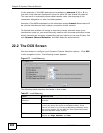
NWA-3160 Series User’s Guide
255
CHAPTER 21
Load Balancing
21.1 Overview
Wireless load balancing is the process whereby you limit the number of
connections allowed on an wireless access point or you limit the amount of
wireless traffic transmitted and received on it. Because there is a hard upper limit
on the AP’s wireless bandwidth, this can be a crucial function in areas crowded
with wireless users. Rather than let every user connect and subsequently dilute
the available bandwidth to the point where each connecting device receives a
meager trickle, the load balanced AP instead limits the incoming connections as a
means to maintain bandwidth integrity.
21.1.1 What You Need to Know About Load Balancing
There are two kinds of load balancing available on the NWA:
Load balancing by station number limits the number of devices allowed to
connect to your AP. If you know exactly how many stations you want to let
connect, choose this option.
For example, if your company’s graphic design team has their own NWA and they
have 10 computers, you can load balance for 10. Later, if someone from the sales
department visits the graphic design team’s offices for a meeting and he tries to
access the network, he won’t be able to because his laptop is device number 11,
which is one more than 10 and thus exceeds the load balance. If one of the
graphic design team’s computers disconnects from the network, then the sales
computer can join.
Load balancing by traffic level limits the number of connections to the NWA
based on maximum bandwidth available. If you are uncertain as to the exact
number of wireless connections you will have then choose this option. By setting a
maximum bandwith cap, you allow any number of devices to connect as long as
their total bandwidth usage does not exceed the bandwidth cap associated with
this setting. Once the cap is hit, any new connections are rejected or delayed
provided that there are other APs in range that have the same settings as the
NWA (such as SSID, security mode, radio mode, and so on).


















